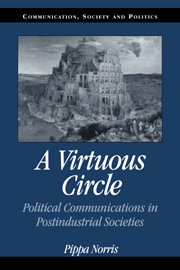Book contents
- Frontmatter
- Contents
- List of Tables
- List of Figures
- Preface
- PART I THE NEWS MEDIA AND CIVIC MALAISE
- PART II TRENDS IN POLITICAL COMMUNICATIONS
- 4 The Decline of Newspapers?
- 5 The Rise (and Fall?) of the Television Age
- 6 The Emerging Internet Era
- 7 The Evolution of Campaign Communications
- 8 The Rise of the Postmodern Campaign?
- PART III THE IMPACT ON DEMOCRACY
- CONCLUSIONS
- Technical Appendix
- Notes
- Select Bibliography
- Author Index
- Subject Index
5 - The Rise (and Fall?) of the Television Age
Published online by Cambridge University Press: 26 February 2010
- Frontmatter
- Contents
- List of Tables
- List of Figures
- Preface
- PART I THE NEWS MEDIA AND CIVIC MALAISE
- PART II TRENDS IN POLITICAL COMMUNICATIONS
- 4 The Decline of Newspapers?
- 5 The Rise (and Fall?) of the Television Age
- 6 The Emerging Internet Era
- 7 The Evolution of Campaign Communications
- 8 The Rise of the Postmodern Campaign?
- PART III THE IMPACT ON DEMOCRACY
- CONCLUSIONS
- Technical Appendix
- Notes
- Select Bibliography
- Author Index
- Subject Index
Summary
Just as there are serious concerns about the future of newspapers, many believe that in recent decades the traditional standards for television news and public-affairs coverage have come under threat from technological and economic developments. The critical factors transforming broadcasting include the following: proliferation of channels on broadcast, cable, satellite, digital, and now broadband services, fragmenting the mass audience; the crises of identity and funding facing publicservice television, which once enjoyed a monopoly throughout most of Europe, following the rise of myriad commercial competitors; the more recent technological convergence with the digitization and compression of images, sounds, and data that has produced a new multimedia environment, breaking down the traditional boundaries between telecommunications, the audiovisual industries, and computers.
These trends have affected the OECD countries to different degrees, with their impact and timing strongly mediated by the existing communications landscape. In the Thatcherite 1980s, deregulation and privatization had profound influences on public-service broadcasters throughout western Europe. Following the fall of the Berlin wall, the transition to democracy in the early 1990s produced an even more radical jolt to public television in central and eastern Europe. Meanwhile, in the United States, the traditional domination of the three major networks experienced an equivalent coup d'etat, cut down in the 1980s by myriad competitors on cable and satellite. Despite the longstanding contrasts between the commercially dominant major networks in the United States and public television in Europe, in recent years they have faced strikingly similar multiplications of outlets and fragmentation of television audiences, raising new concerns about the standards of programming.
- Type
- Chapter
- Information
- A Virtuous CirclePolitical Communications in Postindustrial Societies, pp. 90 - 119Publisher: Cambridge University PressPrint publication year: 2000



